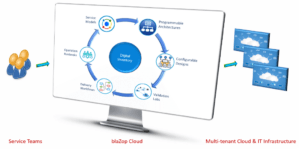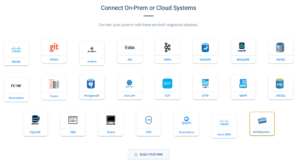I’ve been listening and talking to BlaZop about their interesting product. Maybe you will also find that it sounds interesting and useful…
Note: I provided a draft to BlaZop for review, and I’ve retained but revised some of the additional verbiage they provided, which is in the next section.
Why BlaZop?
BlaZop considers its offering as reinventing the way IT processes and services are operated, addressing one of the biggest challenges of IT Operations: digital infrastructure is digital, but it is managed by (mostly) analog processes. That creates a very complex and costly deployment and support environment involving multiple parties and infrastructure environments.
They emphasize support for “Design, Deliver, Operate” – the phases of cradle-to-grave IT projects.
Historically, IT Operations are built based on operational silos. Workflow passes from one silo to the next. By contrast, BlaZop digitizes IT Operations processes across these Silos to provide “speed, cost, simplicity, productivity, and intelligence.” From the perspective of an IT organization or MSP performing complete tasks and sub-tasks such as “deploy all IT and UC services for a new building,” or “manage all services in a site,” that leads to communications issues and cross-team coordination challenges.
Each tech or operational area or SSOT has its own complexity and limited exposure to the other parts of IT Ops. That adds complexity to any IT operational model and the lifecycle aspects of deployment: architecture, design, implementation, and operations. Key IT Ops efficiency opportunities like simplified planning, end-to-end event correlation, and root cause analysis became impossible. The key insights where the power of data mining and machine learning can be applied became impossible since the integrity of the data could not be achieved in a unified way.
Getting all the teams “on one page” (data in one repository) becomes the key to greater efficiency.
Thus, one of the core aspects of BlaZop is breaking operational silos by digitizing the “architect to operate” process. The focus is Day 0 and Day 1 of IT operations by converting the conventional IT processes into digital blueprints, reducing the role of “gatekeepers,” thus speeding the entire process from architect to operate.
Graphic courtesy of BlaZop, used with permission.
Digitizing and simplifying the way IT operates provides multiple benefits to IT Operations, primarily in large enterprises.
From IT executive point of view: IT Operations today are stretched very thin today. “Throwing bodies at the problem” is no longer an option.
- Operations face two conflicting trends: enabling and accelerating new or existing businesses while reducing costs.
- At the same time, the complexity of operations could become prohibitive. What happens if IT execs do nothing? Either Ops will be overwhelmed and not capable of enabling new business offerings, or Ops will be overwhelmed and not able to meet committed SLAs.
From a process point of view: BlaZop creates an opportunity to accelerate “time to capability” across the “architect to operate” process.
- When IT Operations are properly set up from Day 0, post-deployment management becomes simpler. Everything is documented digitally and in the system.
- Doing so provides the opportunity for model–driven operations and avoiding siloed decision-making.
- Given full digital knowledge of what is in place, AIOps insights such as IT insights, Business insights, and Security insights become feasible for Day 2 IT Ops.
As the vendor puts it: “BlaZop creates the opportunity to combine the elements of NetOps, AppOps, InfraOps, CollabOps, and SecureOps into one cross-domain framework for one or outcome-oriented bundle of blueprints. It paves the way towards excellent experience for every provider or consumer of the service, and it reduces cost and improves major KPIs.”
BlaZop’s target customer appears to be Managed Service Providers (MSPs), large enterprises, and perhaps managed services/consulting firms. That is, organizations that are ready to move to a framework to organize how they collect information and deliver new gear deployments, as well as manage all the information and project tasks involved in getting the gear deployed and subsequently supported. The objective is reduced costs via standardized task and outcome plans, with reduced variety/major customization and better use of staff time.
What Comes With BlaZop?
If you look at the diagram below, and if you try to envision all the things that might belong under each of the items, there could be and likely is a lot of automation under each one. The BlaZop website does not provide that level of deep-dive detail or documentation currently. Frankly, even if it did, I’m not sure I’d want to spend the time to explore in that amount of detail – not intending for this blog to become, in effect, light product documentation!
 Graphic courtesy of BlaZop, used with permission.
Graphic courtesy of BlaZop, used with permission.
The challenge with any “framework” is how much of it is fleshed out or provides a library of sample/starter code etc., as opposed to just a grand design that still requires a lot of coding and other work to implement at a site. BlaZop’s website indicates they’ve done at least some of the detailed component work. But as noted in the prior paragraph, I don’t know enough about the product to accurately estimate what percentage has been fleshed out, at least with fairly solid starter templates, scripts, etc.
Some of what is clearly present:
- BlaZop includes forms to gather information for a consulting or work engagement. Examples include site info, facility info, network services info, network configurations, site connectivity, and BOM details.
- It also provides forms for documentation of workflows (Project Management!).
- And it contains network or traffic flow diagramming tools.
It uses Jinja2 to verify policy compliance for device configurations. And supports Python for “serverless” builds.
Out of box Integrations
With such a comprehensive product, the obvious question is how well it might co-exist with your existing (and likely expensive!) toolset or otherwise called “brownfield integration.” For BlaZop, this can be found under “Integrations,” as “codeless integration” with external systems.
The following screen capture shows the available integrations at the time this blog was written.
 Graphic courtesy of BlaZop, used with permission.
Graphic courtesy of BlaZop, used with permission.
Versus ServiceNow?
The obvious question is where BlaZop fits versus ServiceNow.
I see ServiceNow as a very costly and complex tool (I’ll bet that’s no surprise). One that usually comes from, is owned by, and serves the executive and especially project management side of an organization. Most often, it seems to be used for ticketing and new deployments or problem resolutions. Perhaps CMDB, at least for inventory tracking. And in some cases, pre-planning and tracking of projects/tasks, e.g., adding a new user (with or without a laptop, etc.). Some of the tasks may be automated, others not. BlaZop appears to be similar in the project and sub-tasks aspects.
What I can imagine happening is the ServiceNow team not necessarily wanting to be involved with the fine granularity of network, security, server, VM, and application deployments. It seems like tying in BlaZop might allow the Service OPS teams to deal with the highly technical granularity they need, with approval, ticket, and completion hooks into ServiceNow, in effect at a more macro level. For example, maybe management and ServiceNow care about “install new office site” but not the details. And perhaps BlaZop has the details of how to “install new office site” for example, including parameterization for site specifics (small, medium, large, number of switches, 1 or 2 routers, local firewall, Internet or WAN connection …).
Disclosure: Personal experience with ServiceNow is a couple of large organizations where things worked well. And another that will remain nameless, where it took about a month to get my consulting login, remote accesses, email, etc. processed, and where we never did get some permission problems sorted out.
My take on the latter was too many ServiceNow steps, and nobody owned the need to continually test the steps and the accuracy of the user documentation, resulting in a fragmented and buggy overall process. E.g., I kept opening problem tickets and being told “oh, that URL changed, it is now THIS.” Resulting impression: it’s good for tracking and approvals but needs onsite awareness that ticketing does not fully validate workflows. But that’s another topic, and not something I intend to blog further about.
A Critical Evaluation of BlaZop
Ok, so what do I think of BlaZop?
I’m clearly intrigued, or I wouldn’t be writing about it.
The clear Big Question is: will BlaZop provide an organization quick time to value, or is it massive, requiring a learning and deployment investment before it provides value. It appears it can be “grown into”, i.e., use what you need and bite off more if/when you see value in doing so. Even so, there’d be a learning curve. And with any big management tool like this (InfoBlox, DNAC, ACI, ISE, etc.) I’d want two “experts” (and “owners”) onsite, who know how the tool works, etc.
My current impressions of BlaZop are to some extent limited by the scope of the product and time: big product, it would take a fair amount of time to walk through actual use of the product end-to-end for a small project, and the website does not appear to provide detailed documentation that would let me get a “fast forwarding” feel for the end-user experience, let alone which things it contains or doesn’t, where you have to supply code or details.
It seems BlaZop might usefully help some organizations jump-start a full lifecycle deployment automation process. Or it might be intimidatingly large, and better after you’ve done some piecemeal integrations, where you’re ready to tie that into a documented PROCESS for reliable repeatability. I.e., not for beginning automation and documentation/process work, but might fit well when you’re looking to make that more comprehensive.
BlaZop might really shine if you have a lot of repeatable deployment to do, like deploying or replacing 5,000 hotel, bank branch, or site WAN routers and firewalls.
Note that the process aspect of BlaZop does support manual as well as automated process steps, which facilitates concentrating automation efforts where there is the most value. Not to mention those who are just getting started with automation.
I’ll also note that BlaZop’s ServiceNow integration presumably allows use of ServiceNow for ticketing and approvals, but may allow keeping documentation and all the details out of ServiceNow while providing an overall structure for capturing documentation and details. I assume that’s likely a Thing. I referred to this above: perhaps use BlaZop for technical details, and tie in just enough to satisfy the PM and management folks with ServiceNow focus. Thereby giving networking / security / desktop / data center folks their own tool that better addresses their needs?
That’s where my opinion about the target customers for BlaZop comes from: those who will benefit from consistency and automation of various service delivery tasks, from design to deployment to ongoing operation.
That’s my first critical comment: it is hard up front to tell what comes with the framework in the way of examples or starter forms, diagrams, scripts, etc. Is the focus more on the framework, or does it come with a large library of field-tested implementation examples and starter code? My guess is that it comes with somewhat of a library, and that may expand as BlaZop gains more customer experience.
Another question re suitability: repeatability of deployment tasks. For a “support” MSP (come in and manage some aspect or all of a customer’s network), sales probably start with “provide tech expertise to help manage and/or improve what we have” and perhaps grow to “manage all aspects of the network, etc.”. What I think I see with BlueAlly/Netcraftsmen, is that a consulting/MSP firm has to meet the customer where they are. E.g., our first four SD-WAN/SASE managed services engagements entailed four different vendors’ products!
Thus, a good question would be how well it works with brownfield/first deployment. Adding new services to an existing network seems to fit within the useful scope of BlaZop, especially when they’re things like “deploy a new office or sales site,” “add a Webex screen to a room”, etc.
I’d think repeatability is important with something like BlaZop. Ok, so in networking the overall process steps might be the same, but you would still have to deal with differences in how the devices are deployed and configured, perhaps in design as well. Bills of Material would differ. Etc.
A key question for a potential customer of BlaZop or similar: ratio of overhead (learning to use it, putting info in) to benefit in terms of time saved and better, faster project completions.
Minor gripe: I keep wanting to put an ‘s’ on the end: “BlaZops”. Maybe I’m a slow learner on that front?
As far as competitors, I’m not aware of any. Not that I’ve been looking for or tracking relevant offerings closely.
Links
- BlaZop Home Page
- BlaZop Preview Video
- BlaZop How It Works Page
- BlaZop Feature Videos Page
- RTP Meetup Recording: BlaZop Overview Presentation
Conclusion
If you’re looking to move beyond limited-scale automation, and tie together tools to automate the full design/deploy/operate/decommission lifecycle, BlaZop might be good tool to look at.
Let’s start a conversation! Contact us to see how NetCraftsmen experts can help with your complex challenges.



